




OUR BEST EVER OFFER - SAVE £100/$100
JOIN THE WORLD'S LEADING PROFESSIONAL DEVELOPMENT PROGRAMME
- 12 months membership of Elite Soccer
- Print copy of Elite Player & Coach Development
- Print copy of The Training Ground
Deliveries from wide areas
The focus of this session is on combination play that results in a crossed delivery from a specific wide area. We play with attacking full-backs and like to work the ball into wider positions from which we can deliver quality crosses into the area.
| Area | Use of a half-pitch |
| Equipment | Balls, cones, goals, mannequins |
| No. of Players | Full squad |
| Session Time | 60mins |
The focus of this session is on combination play that results in a crossed delivery from a specific wide area. We play with attacking full-backs and like to work the ball into wider positions from which we can deliver quality crosses into the area.
The first ‘pattern of play’ allows us to place players in their specific positional areas, and permits us to rehearse relevant movements and variety of pass, whilst also working both left and right flanks.
This type of session allows the practice of key movements that we always seek to incorporate, but also strongly encourages players to express themselves by working on timing and variety of runs, creation of space and the seeking of an ‘end product’, for instance an attempt on goal.
This type of pattern of play will be practised at least once per week and almost always the day before a game, as we seek to reinforce key movements and rotations. We can amend the session to ‘tie in’ with our opposition analysis, so for example if we feel forward runs from our midfield players can be effective then we’ll add progressions to the practice which incorporate such movements.
In everything we do, players need to see relevance in the work, recognising the importance of appropriate practice.
What do I get the players to do?
Half-pitch practice (30mins incl. progressions)
In this practice (1), I have allowed for a squad of 20 players including two keepers. Balls start with the two centre-halves, thus allowing them relevant practice in terms of the type of passes they will seek to deliver. The attacking players work in pairs on the edge of the area, and their involvement in terms of combination and link-up play will increase as the drill progresses. The high midfield players (the no.8 and no.10) work off the two central mannequins, while the full-backs and wide players operate on their respective flanks. We alternate sides, both for foot and technique variation, but also as a way of allowing players time to recover their positions.
1

2. The wide player sets the ball to the attacking midfielder who passes into space for the overlapping full-back to attack
3. The two strikers attack near and far posts, ensuring good timing and quality of movement
4. Attackers now aim to score from the crossed delivery
Half-pitch practice – first progression
In this first progression, as shown (2), the set-up here is designed to allow the coach to emphasise timing of movement. The wide player reacts to drag in his respective ‘marker’, thus allowing space for the full-back to work in.
2
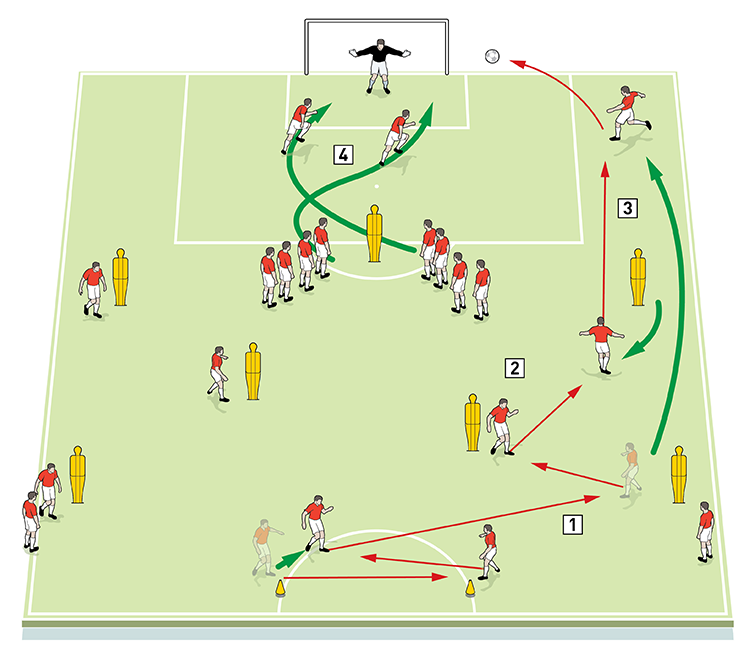
2. He supplies the midfielder, first time
3. The wide player then times his movement to work inside off the flank to receive and pass into the overlapping full-back
4. In the next phase, the next pair of forwards time their movement, looking to focus on the quality of the end product
What are the key things to look out for?
Attention to detail is of paramount importance. If the first pass from the centre-half is poor the entire pattern of play will break down. Therefore, we want players to consider seriously what type of pass the centre-half plays, where the receiving player wants to meet the ball, how good the communication is, and more.
Half-pitch practice – further progressions
In the progressions that follow, we will seek to include the strikers more proactively, as shown (3/4).
3
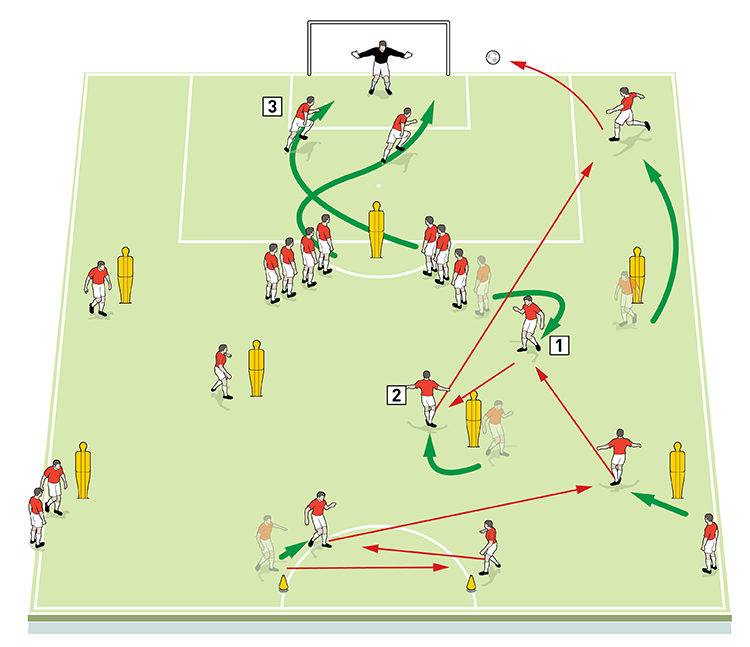
2. As the ball is passed to the forward, the high midfielder works off his mannequin to create space to receive and pass the ball into the forward running wide player
3. The striker and his partner again react to fill key areas to receive the crossed delivery
4
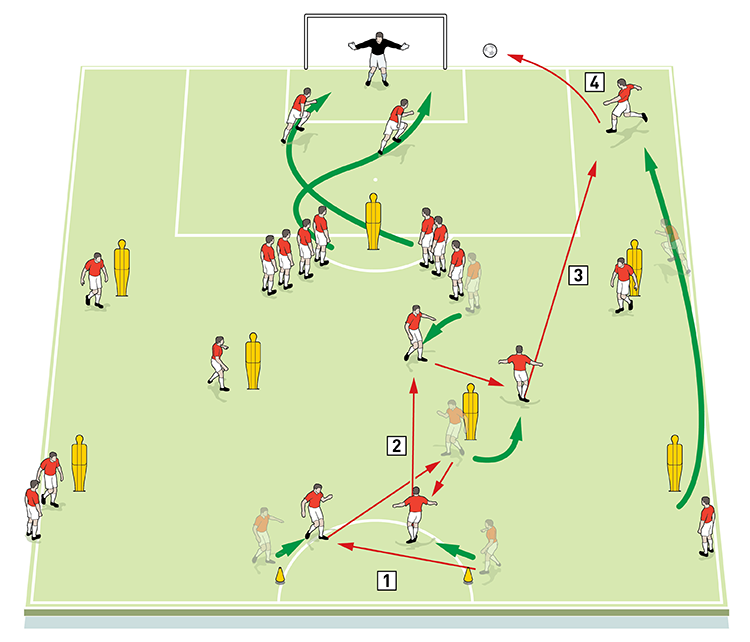
3. Now, the defensive midfielder becomes an attacking outlet, playing a straight pass forward for the overlapping full-back
4. A cross into the box is attacked
What are the key things to look out for?
The focus here is on detail. We need to make sure the wide player does not move too early, thus running into offside position. Timing of movement is constantly focused on with a clear understanding and recognition of the need to both create and maximise space, and as with all practices, seek to ensure a positive ‘end product’, so with that in mind we must also ensure the weight of pass from the midfield player is appropriate, and that the reactions of the striker following his first ‘set’ is explosive into the penalty area.
Also, players must ensure they are working at relevant match pace. Yes, specific coaching points can be highlighted and play slowed to allow ‘learning’, but it is important, especially at first-team level, to have match intensity in all movements.
And as discussed already, the quality of passing throughout is also of key importance, as you would expect, be that pass choice, weight of pass, angle, quality of ‘soft’ or ‘hard’ touch or something else.
If we have a smaller group, we can work one flank at a time, and can set this up to have a wide player from the opposite flank attack the far post. We can seek to add one or two defenders to defend the crossed delivery, thus allowing the coach to work on both offensive and defensive aspects if his contact time with the players is limited.
If detail needs to be worked on or a specific movement improved, we might choose to regress into a relevant passing drill to ensure the movement is both emphasised and recognised.
There are some mistakes we need to make sure we eradicate. These include poor decision- making over choice of pass, poor timing of movement, failure to work off the mannequin and create space, a poor final cross, poor striker movement across the front post, poor communication, or poor tempo and intensity.
All of the above demand concentration and focus. The coach must emphasise the key requirements, but this is supported by the players’ appreciation of the practice demands.
Penalty boxes practice (30mins incl. progressions)
This next set-up is on a 54x36-yard area, with two penalty box-sized areas and two wide channels measuring five yards wide, as shown (5). We have two wide players from both teams occupying their respective wide channels, and for the first part of the drill they are unopposed, with no-one permitted to enter that area.
5
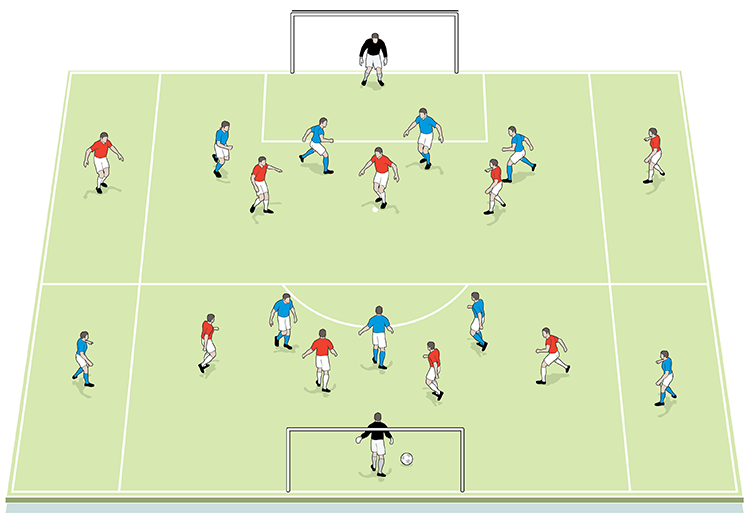
Both teams play 4v3 in their respective defensive areas, and no players can change area at the outset of the game. The keeper can release to a defender, to a wide player or straight into one of his strikers, and the game must be played in normal conditions, as shown (6) , with the exception of wide players being unopposed. These wide players are on a maximum three-touch and must deliver the cross or pass within three seconds. To emphasise the game focus, we often award two points when a goal is scored from a crossed delivery.
6
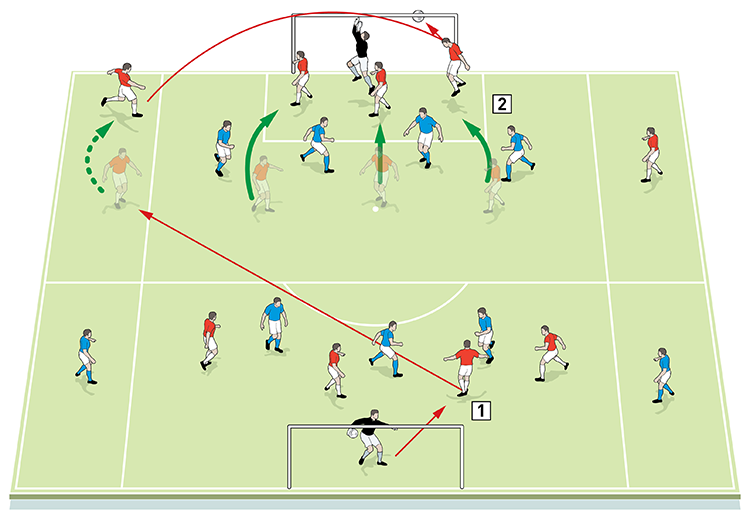
Penalty boxes practice – first progression
The first progression, as shown (7), allows the opposite wide player to attack the far post thus creating a 4v4 situation. Very often, the opposite wide player can approach late and not be marked, thus allowing central striking players to make runs, dragging defenders with them and creating space.
7
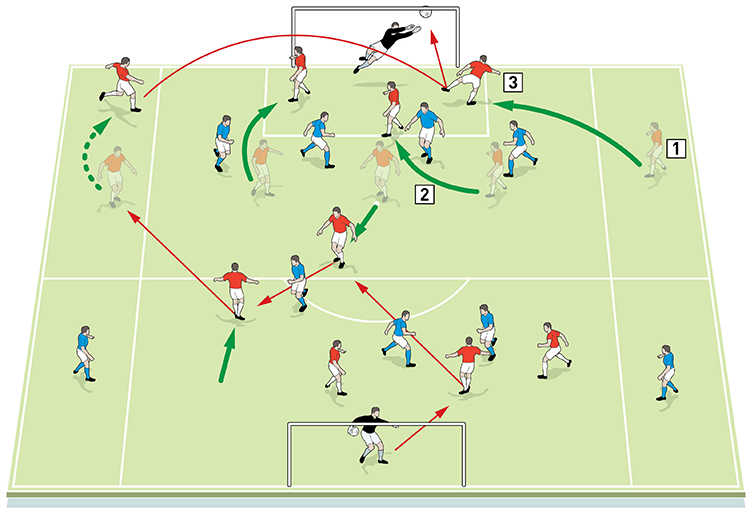
2. His late arrival means defenders are already engaged in tracking and marking the designated attackers
3. Space therefore opens up for the opportunity to score
If the drill breaks down and possession is lost, the wide player must revert to his channel area. If we want to highlight role rotation, we can state that ‘a player’ must fill the wide channel, but not necessarily the initial wide player if someone is closer to that position and can come in to replace him.
Penalty boxes practice – further progressions
In the next progression, one of the four defending players joins the attack to again create a 4v4 situation. This does not mean a defender and the opposite wide player both go, rather one or the other, again encouraging good decision-making and communication.
The third progression sees one of the defenders ‘overlap’ their wide player to deliver a cross, as shown (8). This demands that the wide player then drops in to become a defender to maintain team shape.
8
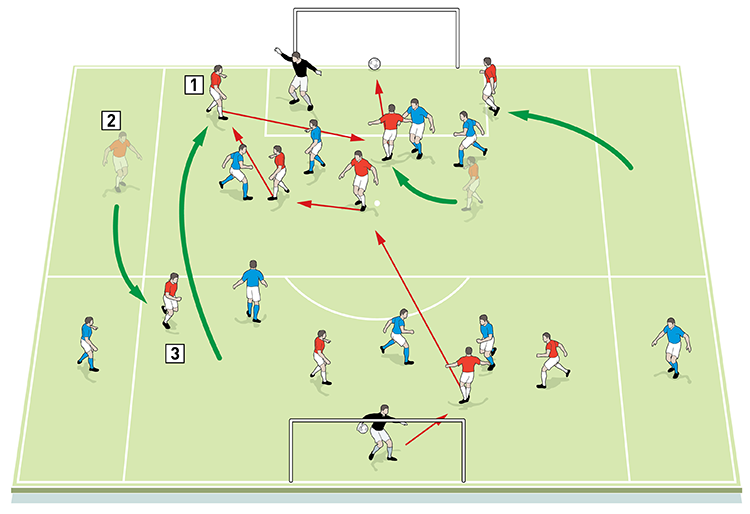
2. In this instance the defender counts as the extra man, meaning the wide man stays in place for the cross
3. This wide player must now provide compensating defensive cover for his team mate who is out of position
How do I put this into a game situation?
The drill can be finished by removing the inner channel markers and allowing a 9v9 game situation within the area, with the focus very much on creating space wide for crossed deliveries.
What are the key things to look out for?
As with our first pattern of play practice, we focus on timing of movement, creation of space, ‘fast’ passing and a desire for crossed deliveries. As always, we seek an end product to the build-up play.
The session can be progressed by limiting touches to two or three per player, and again we look for positive decision-making by the player in possession, with the idea to take care of the ball at all times, maintaining focus and concentration and recognising the aims of the practice. Weight of pass, choice of release, levels of communication and eye contact are all vital to the overall success. Add into that timing and variety of movement – which are always of paramount importance –and it’s clear we are seeking to create and then maximise space to allow for crossed deliveries.
In terms of typical mistakes, players often lose sight of the fact that any such drill is an ‘aspect’ of our game. We should not forget that if a scoring opportunity becomes available, we take it, as opposed to unnaturally passing the ball wide. However, the coach must constantly emphasise the session aims and ‘steer’ the flow of play to achieving said targets.
Related Files
Editor's Picks
Attacking transitions
Deep runs in the final third
Using the goalkeeper in build-up play
Intensive boxes drill with goals
Penetrating the final third
Creating and finishing
My philosophy
Pressing initiation
Compact team movement
Coaches' Testimonials

Alan Pardew

Arsène Wenger

Brendan Rodgers

Carlos Carvalhal

José Mourinho

Jürgen Klopp

Pep Guardiola

Roy Hodgson

Sir Alex Ferguson

Steven Gerrard
Related
Pre-season fitness plan
Play around to play through
Free-kick routines
Coaches' Testimonials

Gerald Kearney, Downtown Las Vegas Soccer Club

Paul Butler, Florida, USA

Rick Shields, Springboro, USA

Tony Green, Pierrefonds Titans, Quebec, Canada
Join the world's leading coaches and managers and discover for yourself one of the best kept secrets in coaching. No other training tool on the planet is written or read by the calibre of names you’ll find in Elite Soccer.
In a recent survey 92% of subscribers said Elite Soccer makes them more confident, 89% said it makes them a more effective coach and 91% said it makes them more inspired.
Get Monthly Inspiration
All the latest techniques and approaches
Since 2010 Elite Soccer has given subscribers exclusive insight into the training ground practices of the world’s best coaches. Published in partnership with the League Managers Association we have unparalleled access to the leading lights in the English leagues, as well as a host of international managers.
Elite Soccer exclusively features sessions written by the coaches themselves. There are no observed sessions and no sessions “in the style of”, just first-hand advice delivered direct to you from the coach.







